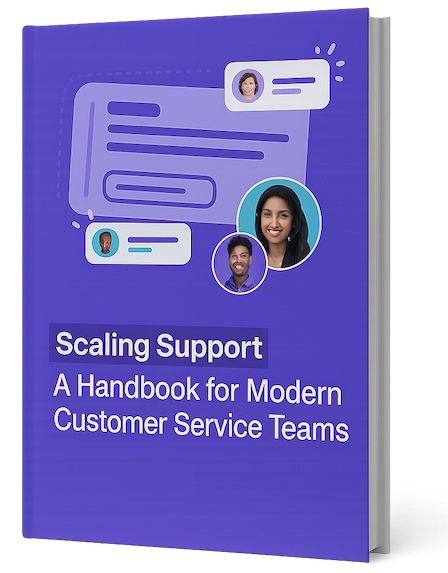Building good customer relationships directly affects your company’s success and growth. When you invest time in connecting with customers, you’re not just making single sales – you’re building a foundation for repeat business. Think of it as planting seeds that grow into long-term customer loyalty and organic word-of-mouth marketing.
The Financial Benefits of Strong Customer Relationships
Strong customer connections boost profits in several key ways:
- Increased Customer Lifetime Value (CLTV): Customers who feel valued spend more money with your business over time
- Reduced Customer Churn: Good relationships make customers less likely to switch to competitors, saving you the high costs of finding new customers
- Better Sales Results: When customers trust you, they’re more open to buying what you offer
The data shows just how much relationships matter. According to research by Bain & Co, repeat customers spend 67% more than new ones. Yet only 18% of companies focus more on keeping existing customers versus the 44% that prioritize finding new ones. The numbers don’t lie – it’s 4x easier to sell to current customers than new prospects. Check out more stats here: Building rapport with your customers.
Turning Satisfied Customers Into Brand Advocates
When you build strong connections, happy customers naturally become your best marketers. They tell friends and colleagues about their great experiences, creating authentic recommendations that new customers trust. This kind of organic promotion is incredibly valuable for growing your brand’s reach and reputation.
Measuring the ROI of Rapport
While measuring relationship-building ROI takes more work than tracking standard marketing metrics, it’s both possible and essential. Focus on key numbers like:
- Customer retention rates
- Customer lifetime value
- Net Promoter Score (NPS)
By linking these metrics to revenue growth, you can show exactly how investing in customer relationships pays off. Use this data to improve your strategies and make smart decisions about where to focus your team’s efforts.
The Psychology Behind Meaningful Customer Connections
Building rapport with customers goes beyond simple pleasantries. By understanding core psychological principles, companies can create lasting connections that truly matter. These genuine emotional bonds help build customer loyalty and encourage word-of-mouth promotion.
Understanding Customer Cues
Reading and interpreting how customers communicate is essential for building strong relationships. Pay attention to both verbal signals (tone and word choice) and non-verbal signs (body language and facial expressions). For instance, quick, short responses often indicate frustration, while steady eye contact and smiling suggest openness. Recognizing these signals helps you adjust your approach to better serve each customer’s needs.
Adapting Your Communication Style
Each customer interaction deserves its own unique approach, since every person communicates differently. The key is being able to adapt your style based on the customer’s personality and emotional state. This could mean matching their pace of speech or adjusting your tone to help them feel understood. When you personalize your communication, customers feel valued and develop a stronger connection with your business.
The Importance of Authenticity
Trust forms the bedrock of all customer relationships, and being genuine is crucial for building that trust. Customers quickly spot fake friendliness, which can permanently damage relationships. Focus on showing real empathy and a sincere desire to help in every interaction. Listen carefully to their issues, validate their feelings, and work to find solutions that fit their specific situation. According to Salesforce, businesses that make authentic connections see better sales numbers, stronger customer loyalty, and higher retention rates. When customers feel truly understood, they’re more likely to keep buying and recommend your company to others. This creates a positive cycle where satisfied customers become enthusiastic supporters of your brand.
Mastering the Art of Active Listening

Active listening is at the heart of building strong customer relationships. When you truly listen, you pick up not just the words being said, but also the emotions, concerns and needs that customers express. This deeper connection helps create trust and understanding between you and your customers.
Beyond Hearing: The Essence of Active Listening
To listen actively means giving your full attention and really trying to understand the customer’s point of view. When you set aside distractions and preconceptions, you can catch subtle hints about what customers are really feeling and needing. For instance, if a customer mentions being “busy,” careful listening might reveal that they’re actually frustrated by a complicated process.
Verbal and Nonverbal Cues: Decoding the Customer Message
Verbal and nonverbal cues both play key roles in active listening. Simple verbal responses like “I understand” and “okay” show you’re engaged and encourage customers to share more. In face-to-face or video meetings, maintaining eye contact and positive body language reinforces that you’re paying attention. These small acknowledgments make a real difference – customers feel heard and understood. As noted by Zendesk, using verbal signals like “yes” and “uh-huh” shows you’re following along and helps solve problems more effectively.
Implementing Active Listening Across Communication Channels
The core principles of active listening work across all platforms – phone, chat, email, and social media. The key is showing empathy and a real desire to help, while adapting your approach for each channel. When you maintain this focus on understanding customers’ needs, you build trust no matter how you’re communicating.
Training Your Team for Active Listening Success
Teaching active listening skills to your customer service team is vital for long-term customer satisfaction. Key training areas include:
- Identifying both verbal and non-verbal cues: Reading tone, pauses, and body language along with spoken words
- Asking clarifying questions: Getting customers to share more details
- Summarizing and paraphrasing: Showing you understand and confirming details
- Responding empathetically: Acknowledging customer feelings and concerns
When teams master these skills, they build stronger customer relationships that lead to greater loyalty and better brand reputation. By emphasizing active listening, you create a culture of understanding that helps resolve customer issues more smoothly and effectively.
Designing Memorable Customer Experiences
Great customer relationships come from creating experiences that stick with people and make them want to come back. Going beyond basic service allows you to build real connections that turn casual customers into loyal fans. When done right, each interaction becomes a chance to strengthen these bonds.
Personalizing the Customer Journey
The key to memorable experiences is personalization. Simple things like remembering previous purchases or communication preferences show customers you value them as individuals. This personal attention helps form authentic connections that go deeper than typical business transactions. When customers feel truly understood, they’re more likely to stay loyal over time.
Turning Conflicts Into Connection Opportunities
Problems and complaints can actually help build stronger relationships when handled well. Taking time to really understand the customer’s perspective and working together on solutions shows you genuinely care. By responding with empathy and a real desire to help, you can transform a negative situation into a positive memory. This builds trust and shows customers you’ll be there even when things don’t go perfectly.
Creating Moments of Delight
Small unexpected touches make a big impact. Whether it’s a handwritten thank you note, thoughtful gift, or just going the extra mile to help, these moments of delight help your business stand out. The impact is clear – according to Listen Trust, 89% of customers make repeat purchases after a great service experience. Learn more about customer loyalty statistics.
Building Scalable Experience Design
For consistent excellent service across your organization, you need clear systems and guidelines. This means developing strong training programs and standards that help every team member deliver outstanding experiences. When everyone understands how to create meaningful customer interactions, it builds a culture focused on relationships rather than just transactions.
Building Excellence in Customer Service Teams

The bonds customer service teams build with clients directly shape brand perceptions and repeat business. When companies invest in developing exceptional teams, they create lasting customer relationships that drive growth. This means going beyond basic training to build a culture centered on authentic human connections.
Effective Coaching Techniques for Rapport Building
Good coaching is essential for teams to excel at connecting with customers. The focus should be on equipping staff with real relationship-building abilities rather than just following scripts.
- Active Listening Skills: Team members learn to fully understand what customers are saying – both directly and indirectly
- Natural Empathy: Staff develop genuine care and understanding for customer situations
- Flexible Communication: Training helps agents adjust their style to match different customer preferences
Team members can practice these skills safely through role-playing exercises. This allows them to receive feedback and refine their approach before working with actual customers.
Performance Measurement: Encouraging Relationship Building
While metrics like resolution speed matter, they don’t capture relationship quality. Teams need measures specifically focused on connection-building:
- Customer Satisfaction (CSAT): Direct feedback on service quality
- Net Promoter Score (NPS): Shows if customers will recommend your business
- Customer Comments: Written feedback reveals relationship strengths and gaps
Simply chasing efficiency can damage customer bonds. Quality service drives loyalty – not costs. According to Plecto, 90% of Americans say service affects their buying choices. 50% leave after one bad experience, rising to 80% after multiple poor interactions.
Maintaining Consistency Across Large Teams
As teams expand, keeping service and relationship quality consistent becomes harder. Success requires:
- Core Training Materials: Give everyone the same foundational skills
- Team Discussion Forums: Share best practices and tackle challenges together
- Communication Tools: Platforms like Slack help teams collaborate and share knowledge quickly
These elements create a unified team focused on building meaningful customer relationships that improve retention and fuel company growth.
Measuring and Optimizing Relationship Building Success

Building strong customer relationships needs constant evaluation and improvement. A strategy alone isn’t enough – you need to track results and refine your approach based on real data.
Quantitative Metrics: Measuring the Tangible Impact
Quantitative metrics help you track concrete results from your relationship-building efforts. Key metrics to monitor include:
- Customer Retention Rate: The percentage of customers who stay with your business over time. Higher retention often shows stronger relationships.
- Customer Lifetime Value: The total expected revenue from one customer relationship. Better rapport tends to increase this value.
- Conversion Rates: How often customer interactions lead to sales or sign-ups. Good relationships can boost these numbers.
- Average Resolution Time: How quickly your team solves customer issues. Fast, effective solutions build trust.
Qualitative Metrics: Understanding the Customer Experience
While numbers matter, qualitative metrics reveal deeper insights about how customers feel. Consider tracking:
- Customer Surveys: Get direct feedback through targeted questions. Open-ended responses often provide rich insights.
- Customer Reviews: Monitor online feedback to understand public perception. Both positive and negative reviews offer learning opportunities.
- Social Media Comments: Track what customers say about your brand across social platforms.
- Focus Groups: Have in-depth discussions with customers about their experiences with your team.
Analyzing Interaction Data: Finding Opportunities for Improvement
Looking closely at customer conversations reveals important patterns. By studying calls, chats and emails, you can spot:
- Common Issues: Identify recurring problems so teams can address them proactively.
- Training Needs: See where staff excel at building connections and where they need coaching.
- Process Gaps: Find and fix bottlenecks that slow down service and frustrate customers.
Linking Metrics to Business Outcomes: Demonstrating the Value of Rapport
Show how better customer relationships affect your bottom line. Connect improved retention to revenue growth. Track how stronger rapport reduces customer losses. Clear links between relationships and results help justify investing in rapport-building programs.
For help managing customer feedback and team communication, try Supportman. It connects Intercom ratings to Slack, giving real-time insights to help teams build better customer relationships. Start your free trial today – no credit card needed!


